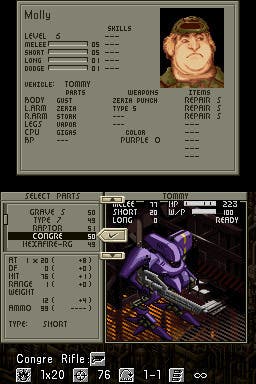Front Mission
Nothing to do with lads' mags. Although it does have a few Wanzers.
Front Mission on the DS is pretty much exactly the same game as Front Mission on the SNES. Which, since it wasn't ever released in Europe, might not mean much to you unless you're the sort of hardened import gamer for whom only kanji will suffice. So, just in case you aren't, it means this: it's a turn-based strategy game in which squads of bipedal metal robots wander across isometric landscapes and fight each other with guns. And the robots are called wanzers. Snigger.
It also means that the visual aesthetics and interface design both look and feel a bit dated. Take, for example, the character art. Yoshitaka Amano, who's better known for his work on the Final Fantasy series (and ‘The Dream Hunters', his collaboration with Neil Gaiman), has rightfully acquired a near legendary status in the intervening years but, here, the pixelly interpretations of his character designs resemble slightly dodgy fan art. So the game's lead character, who goes by the slightly strange name of Royd, resembles a 13-year-old lesbian, even though she's actually a he, as becomes clear when his fiancee gets blown up at the start of the game.
In fact, the slightly silly backstory, sparked into life by this tragic murder, is equally amateurish, featuring the sort of dystopian guff that passed for the height of sci-fi storytelling twelve years ago. It basically consists of two fictional superpowers (the Oceania Community Union or OCU and the United States of the New Continent or USNC) fighting it out because of failed peace treaties and so on. But in spite of all the decade-old foibles, the game does have a period charm that shines through even now.

And beneath it all, Front Mission is an undeniably superb strategy game. The battlefield mechanics are simple. During the player phase, you select your units one at a time, moving them and then opting to either attack (if in range), or use an item. Then, after the enemy phase, the cycle begins again. There's nothing sophisticated here, like managing initiative, or moving after you attack, or using action points or anything like that. No, the challenge, and the difficulty (which can be fairly steep), arise from negotiating the terrain, which provides varying degrees of cover, and from learning to make effective use of your pilots, and their skills and wanzer configurations.
Which means that the time you spend in the hangar, buying new parts, and assembling perfect fighting machines, specially tailored to each member of your team, is every bit as important as the time you spend out in the field. It has to be said that the interface design doesn't make this part of the game particularly easy, since it's not always easy to compare your new parts with old ones. Moreover, picking the right wanzer parts and configurations, and matching them to your pilots and their skills is overwhelming enough as it is. But with effort and determination, would-be wanzer captains will soon start to get a feel for what works on the field of battle, and that's when the game really clicks.

That, though, is the game's biggest drawback: it's certainly not a game that is immediately accessible, and the game's enormous scope and depth might actually count against it in the eyes of a novice. Non-novices, however, will take enormous pleasure from the game's unreconstructed old-school appeal.
They'll also enjoy a load of other stuff, like the ability to participate in and gamble on one-on-one arena encounters, to earn money for parts. Or, since the game is modelled on the PSone re-release of the SNES original, the ability to play through a second single-player campaign (which tells the story from the side of the USNC, unlike the original campaign, which features the OCU). Indeed, Front Mission fans will also relish the many minor DS-exclusives too, such as playable characters from later games, along with new parts, new weapons, new areas, and new missions.
And that's Front Mission on the DS: essentially the same game that didn't come out over here on the SNES 12 years ago. Except better, and with more content, and with easy touchscreen navigation of menus. It's not as sophisticated as more recent Front Mission games, but since most people in Europe won't have played too many of those, that doesn't matter so much. More problematic is the amount of effort that players will have to put in before they're able to take any pleasure from the game. But, then, that's why it's so good. And that's why it's still relevant today, and more than just a historical curiosity.
